California’s state flag is a powerful symbol of resistance and unity in the face of a cruel, lawless presidential administration. Across California, people are taking down their American flags and flying the California flag instead.
What if Californians want our elected local governments to do the same thing? Is that legal? And if not, what else can we do?
There are at least four big opportunities for pro-independence activists to organize locally around how California governments fly flags. But first, we need to know the law inside and out.
I’m going to start by laying out why it matters what flags we fly. Then we’ll take a look at relevant state law. We’ll learn when and why it’s okay to fly the American flag upside-down. I’ll explain what the heck a charter city is and why they have so much autonomy. We’ll take a look at a pending California court case about flags. Finally, we’ll run through all four ways you and other pro-independence Californians can change the way local governments fly flags.
Why do flags even matter?
I don’t know if you remember this guy, but when he became California’s governor in 2019, during the heart of the first Trump administration, he made a point of giving his inauguration speech with nothing but California flags in the background. Not a single American flag in sight!
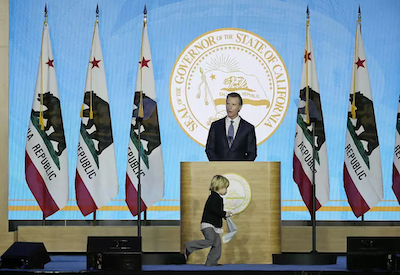
What a powerful symbol to back his promise of a “progressive, principled California”! “It is up to us to renew the California dream for a new generation. And now more than ever, it is up to us to defend it,” he said. “But there is an administration in Washington clearly hostile to California’s values and California’s interests.”
It’s possible this gesture never meant that much to a man who now seeks on-air advice with authoritarians and Nazi sympathizers. But it meant a lot to ordinary Californians! On the one side, there was the Trump administration, cruel and anti-democratic. And on the other was—us! Pro-immigrant, pro-rule-of-law. And as anyone who’s ever voted in a California election knows, we love the heck out of democracy. Lots of places in the world vote, but California ballots are truly next level.
At a time when the second Trump administration is targeting law-abiding California immigrants, threatening to slash Medicaid, and openly defying court orders, why should Californians even care about flags?
Because flags remind us who’s in charge. California is not and has never been a subsidiary of the federal government. We’ve always had our own sovereignty. The federal government doesn’t even have its own source of funds; in most years, every federal dollar they spend on us comes directly from taxes we pay to them!
Voluntarily flying our own flag below the American flag is literally a symbol of inferiority and compliance. So much for “do not obey in advance”! Californians can do better.
A look at the law
If we want cities to fly the California flag as a symbol of democracy and the rule of law, we probably shouldn’t do it in a way that breaks California law. What does the law say?
California’s Government Code has a chapter entitled “Display of Flags,” most of which became law in 1953. It has three sections that are especially important to local government:
Section 430 says the California and American flags have to be displayed “In all rooms where any court or any state, county, or municipal commission holds any sessions.”
Section 431 lays out a list of places where the California and American flags “shall be prominently displayed during business hours upon or in front of the buildings or grounds of.” These include “each public building belonging to the State, a county, or a municipality” and “at the entrance or upon the grounds or upon the administration” of high schools and colleges.
Section 436 mandates the relationship between the California and American flag:
- when both are used together, “they shall be of the same size”
- if they’re on the same flagpole, the American flag must be on top
- the American flag must be “placed in the position of first honor.”
California law doesn’t define “position of first honor,” but it’s almost certainly referencing Section 7 of the U.S. Flag Code (“position and manner of display”). Basically, it means: in front, on top, on the right, or, when it’s with a bunch of other flags, in the middle. Like I said, flags are about showing who’s in charge.
Don’t worry, I’m not going to run you through the U.S. Flag Code, too, for the simple reason that it’s advisory and non-binding. Not even on the federal government! For now, just know that it exists.
Meaning no disrespect
It’s looking a lot like California cities do have to fly the American flag—at least until we change state law. But there are a couple of things that state law doesn’t say.
First, it doesn’t require special districts to fly any flags at all. Your local hospital district, park district, or utility district could get away with flying just the California flag. (If they choose to fly an American flag and a California flag together, the rules about size and position still apply.)
Second—here’s the big one—nowhere does the law say California cities have to fly the American flag right-side-up.
Flying the American flag upside-down isn’t just being silly or even disrespectful. It’s a symbol of distress. As Section 8 of our friend the U.S. Flag Code reads: “the flag should never be displayed with the union down, except as a signal of dire distress in instances of extreme danger to life or property” (emphasis mine).
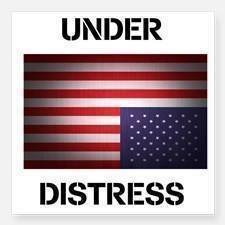
I don’t know about you, but to me “extreme danger to life or property” sounds a lot like the Trump administration. I mean literally, in the sense of “Californians will die and lose our homes in a wildfire because of this guy.” The latest: thanks to Trump, the National Weather Service no longer provides 24/7 extreme weather alerts to 7 million Californians.
It’s a municipal affair
There’s one huge exception to the rule that California cities have to fly the American flag: charter cities.
What are charter cities? Literally, cities that voted to adopt their own charter (basically, the constitution of the city). In California, adopting a city charter automatically gives your city supreme authority over its own municipal affairs. Think of it as California’s version of federalism.
As you might have guessed, defining “municipal affair” is rather complex. There are cases in which the state government can still tell a charter city how to run its own affairs, but the state has to prove in court that there is a need for “paramount state control” in those particular areas—which is a stretch when it comes to flags. The California constitution also lays out four core powers of charter cities, one of which is “subgovernment in all or part of a city,” which almost certainly applies to how the city adorns its own government buildings. Moreover, a recent appellate court ruling found that state laws definitely don’t override charter cities’ autonomy unless they explicitly say so (and the 1953 law on Display of Flags definitely does not).
Do you live in a charter city? While only about a quarter of California cities are charter cities, they tend to be the largest cities (literally, everything larger than Fremont, which has just over 228,000 people, is a charter city). As a result, about half of all Californians live in a charter city. California has many small charter cities as well, including Needles (pop. 4,959).

If your city is on this list (or it adopted a charter in the last decade), your city has full autonomy over which flags it flies at its own government buildings. They could fly:
- just a California flag
- a California flag above an American flag
- a really big California flag above a really little American flag
- the lone red star flag
- no flag at all (Piedmont does this)
Whose government speech?
There’s an argument that even general law cities (the “normal” kind that have no charter) should be able to decide what flags they fly out of respect for freedom of (government) speech and the initiative system. It’s maybe not the strongest argument, but it’s one that’s being considered by California’s appellate courts right now.
In November 2022, a majority of the voters of Arcata, California, voted for an initiative to fly the Earth flag (literally, a picture of the Earth on a blue background) above both the American and California flags.
The Earth flag had a good year-and-half run until, in 2024, the Humboldt County Superior Court ruled the American flag had to be on top, noting “as a general law city created by the state, Arcata must comply with such mandatory provisions of state law, even if voters say otherwise.”
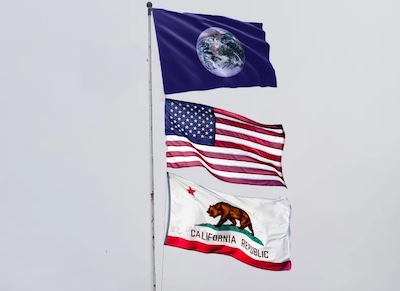
The sponsors of the initiative appealed, and here we are. There should be a decision one way or the other this June.
Four ways to organize
One of the best ways to organize a movement is to start locally. Get people working face-to-face on a common cause, rack up some small local victories, and use that momentum to branch out to bigger battles and higher levels of government.
Local organizing is tricky for the California independence movement, whose primary agenda is for our state government to take over the functions of the federal one.
Getting your local government to change how they fly flags is low-hanging fruit for the California independence movement. Not only is it local; it’s fast. Normally, if you get a government body to agree to a new policy, it takes months if not years to actually put the policy into action. With flags, there’s no staff to hire, no environmental impact report to file, and (usually) no commissions to get approval from. Once the policy passes, it goes into effect the next day. It’s basically activist candy.
Ever wondered why the authoritarian right makes such a fuss about pride flags? Now you get it!
Here are four different ways that pro-independence activists can organize around getting local governments to change how they fly flags, in roughly increasing order of difficulty.
1. Enforce the law
Sometimes local governments “forget” to fly the California flag (like Orinda did in 2019), or they fly a giant American flag over a smaller California one. Unless they’re a charter city (or a special district only flying a single flag), they’re breaking the law!
If you notice that a California government is violating state flag law, do what any law-abiding Californian would do: bring it to the attention of the government body (preferably at a public hearing, with lots of your friends in attendance) and threaten to complain to the court system. As California Government Code § 437 says, “The superior court having jurisdiction of the offense shall enforce this chapter [Display of Flags] on the complaint of any citizen of the county.” Unlike with most local organizing, it doesn’t matter how small or disorganized your group is; if you can file a lawsuit, you can win.
Oh, and if you happen to be a citizen of Sacramento County, there’s one pretty big target you can go after: the state government. The state legislature archives videos of its hearings, and they invariably start with several minutes of webcam footage pointing at the state Capitol while the hearings convene or whatever. Check out this video, for example. See that in the foreground? That’s the Legislative Office Building (affectionately known as the LOB), and on it flies an American flag that’s definitely a little bigger than the California flag. Here’s a clip from 0:07 seconds into the video:
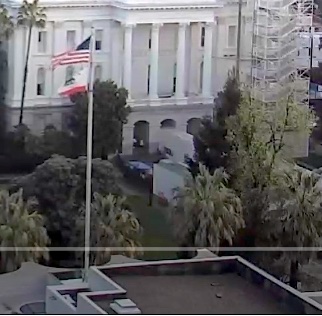
But, California Government Code § 436! And if that makes your blood boil—content warning—then definitely don’t fast forward to 12:30 where you can see the same thing happening on our State Capitol itself.
Seriously, whoever’s running the state government (Gavin somebody?) should do something about that.
2. Fun with special districts
The framers of the 1953 law on Display of Flags neglected to include special districts. As a result, nothing requires them to fly the American flag at all. See if you can get your local special districts to just fly the California flag. A bare bear flag! (And think of the 50% cost savings in flag purchases! DOGE would certainly approve.)
Wait, what is a special district? Pretty much any government body with “district” in its name that isn’t a school district or community college district. Some examples:
- The San Francisco Bay Area Rapid Transit District (BART)
- The Sacramento Municipal Utility District (SMUD)
- The Santa Maria Airport District (welcome to California!)
Special districts are everywhere in California, but they’re also largely invisible. Just look at how many health care districts there are in California. If you and your activist friends show up at a special district meeting, you’re likely to be the only ones making public comment. Low-hanging fruit!
3. A signal of dire distress
The third way to organize is to convince local governments that aren’t special districts or charter cities to fly the American flag upside-down. That includes general law cities, counties, and school and community college districts.
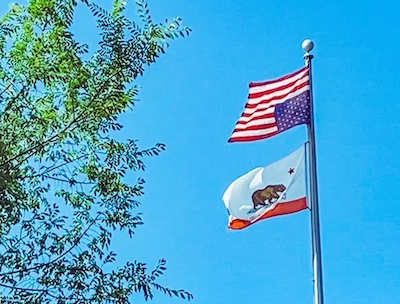
One angle is to lean hard into the upside-down flag as a legitimate symbol of distress. Maybe, rather than making it a permanent change, you can get them to pass an ordinance to fly the American flag upside-down for as long as the Oval Office is occupied by a convicted felon or his running mate.
4. Charter cities do what they want
Finally, if you live in a charter city, just do whatever works for people in your city. Maybe fly your city flag on top, the California flag below, and a tiny American flag on the bottom. Maybe work the Earth flag in there somewhere. Really, go with whatever sparks the imagination and doesn’t piss off your allies.
One big practical reason for municipal governments to stop flying the American flag is to build trust with California’s immigrants. Our local governments have gone to tremendous lengths to make the nearly five million Californians who don’t hold U.S. citizenship feel safe, by stressing that they don’t enforce immigration law. Flying the same flag as ICE does muddles that message.
I listed this activism opportunity last (most difficult) because charter cities tend to be big. Convincing the city of Los Angeles to stop flying the American flag might be something we’d want to build momentum towards after notching other local victories. But not all charter cities are giant; some of them just wanted to have their own charter. Sand City, for example, is a charter city with a population of just 325!
You might be surprised to learn you live in a charter city too, so check the list!
Imagine it so we can do it
Try to imagine how California might look once we negotiate independence from the United States and become our own country. What would be different?
In most of the places where you see an American flag flying today, we’d almost certainly be flying a California flag instead. American flags would still be around, but they’d be for, like, historical Gold Rush stuff, or for people who recently immigrated from America and want to express their ethnic identity.
That’s why changing the flags we fly matters so much. Rather than Californians having to imagine an independent California through a work of fiction or some such, they could see it already happening all around them. And if we can imagine it, we can make it happen.
